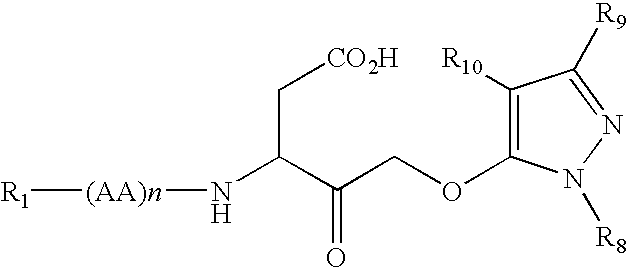Dipeptide apoptosis inhibitors and the use thereof
a technology of apoptosis inhibitors and dipeptides, which is applied in the field of medicinal chemistry, can solve the problems of no inhibitors with good efficacy (icsub>50, sub>1 m) in whole-cell models of apoptosis, and achieves potent inhibitors of apoptosis, potent inhibitors of antifas-induced lethality, and robust neuroprotective effects
- Summary
- Abstract
- Description
- Claims
- Application Information
AI Technical Summary
Benefits of technology
Problems solved by technology
Method used
Image
Examples
example 1
t-Butyl 5-fluoro-4-hydroxy-3-nitropentanoate
[0101]A solution of oxalic acid (1.9 mL, 21.8 mmol) in dry CH2Cl2 (100 mL) was cooled to −78° C., a solution of DMSO (3.0 mL, 42.3 mmol) in dry CH2Cl2 (10 mL) was added with stirring in such a rate that the temperature was kept at −50 to −60° C. After 5 min stirring, a solution of 2-fluoroethanol (1.2 mL, 18.4 mmol) in dry CH2Cl2 (10 mL) was added, and stirring was continued for an additional 15 min, then dry Et3N (13.5 mL) was added. The reaction mixture was stirred for 15 min, then allowed to warm to rt. To the reaction mixture was added a solution of t-butyl 3-nitropropionate (2.87 g, 16.38 mmol) in CH2Cl2 (20 mL). The reaction mixture was stirred at rt for 3 h, then poured into water (100 mL). The organic layer was separated and the aqueous was extracted with CH2Cl2 (2×50 mL). The CH2Cl2 solution was washed with brine, dried and evaporated. The residue was purified by chromatography twice over silica gel (hexane-EtOAc, 7:3) to give 950...
example 2
t-Butyl 3-amino-5-fluoro-4-hydroxy-pentanoate
[0102]To a solution of t-butyl 5-fluoro-4-hydroxy-3-nitropentanoate (950 mg, 4.0 mmol) in MeOH (20 mL) was added Raney Ni (about 200 mg), the mixture was shaken under H2 (30-35 psi) at rt for 18 h. It was filtered and the catalyst was washed with MeOH (2×10 mL). The MeOH solution was evaporated and the residue was purified by chromatography over silica gel (EtOAc-MeOH, 10:1) to give 840 mg (96%) of the titled compound as a yellowish viscous oil. 1HNMR (CDCl3), 1.450 (s, 9H), 2.12 (bs, 3H, OH and NH2), 2.28-2.38 (m, 1H), 2.47-2.57 (m, 1H), 3.24-3.30 (m, 1H), 3.54-3.76 (m, 1H), 4.38-4.48 (m, 1H), 4.54-4.61 (m, 1H).
example 3
t-Butyl 3-(Cbz-Val-amido)-5-fluoro-4-hydroxy-pentanoate
[0103]To a solution of Cbz-Valine (396 mg, 1.58 mmol) in THF (20 mL) was added 1-(3-dimethylaminopropyl)-3-ethylcarbodiimide (EDCI) (300 mg, 1.57 mmol), 1-hydroxybenzotriazole hydrate (HOBT) (240 mg, 1.57 mmol) and dimethylaminopyridine (DMAP) 129 mg 1.06 mmol). The resulting mixture was stirred for 5 min, then was added a solution of t-butyl 3-amino-5-fluoro-4-hydroxy-pentanoate (215 mg, 1.04 mmol) in THF (10 mL) and it was stirred at rt for 18 h. The mixture was filtered and the THF solution was evaporated, and the residue was purified by chromatography over silica gel (hexane-EtOAc, 3:2) to give 290 mg (68%) of the titled compound as a white solid. 1HNMR (CDCl3), 0.905 (d, 3H, J=7), 0.965 (d, 3H, J=7), 1.428 (s, 9H), 2.07-2.16 (m, 1H), 2.50-2.57 (m, 1H), 2.64-2.70 (m, 1H), 3.52 (bs, 1H, OH), 3.92-3.96 (m, 2H), 4.20-4.27 (m, 1H), 4.40 (bs, 1H),4.49 (bs, 1H), 5.10 (s, 2H), 5.31-5.4 (m, 1H, NH), 6.86-6.93 (m, 1H, NH), 7.350(s, 5...
PUM
| Property | Measurement | Unit |
|---|---|---|
| temperature | aaaaa | aaaaa |
| temperature | aaaaa | aaaaa |
| concentrations | aaaaa | aaaaa |
Abstract
Description
Claims
Application Information
 Login to View More
Login to View More - R&D
- Intellectual Property
- Life Sciences
- Materials
- Tech Scout
- Unparalleled Data Quality
- Higher Quality Content
- 60% Fewer Hallucinations
Browse by: Latest US Patents, China's latest patents, Technical Efficacy Thesaurus, Application Domain, Technology Topic, Popular Technical Reports.
© 2025 PatSnap. All rights reserved.Legal|Privacy policy|Modern Slavery Act Transparency Statement|Sitemap|About US| Contact US: help@patsnap.com



